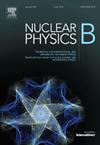当标准模型希格斯粒子遇到更轻的95 GeV孪生粒子时
IF 2.5
3区 物理与天体物理
Q2 PHYSICS, PARTICLES & FIELDS
引用次数: 0
摘要
最近来自大型强子对撞机的报告指出了两种过度:一种是在95 GeV左右的较轻希格斯质量区域,另一种是在标准模型(SM) 125 GeV希格斯衰变的罕见Zγ最终状态。这些异常是在最小测量双希格斯双重态模型(G2HDM)中分析的。在G2HDM中确定了一个可行的参数空间,可以解释这两个过度。在可行参数空间内,我们发现sm125 GeV希格斯粒子的信号强度衰减到γγ和Zγ模式之间存在很强的相关性。然而,这种相关性并不适用于较轻的95 GeV希格斯粒子。本文章由计算机程序翻译,如有差异,请以英文原文为准。
When The Standard Model Higgs Meets Its Lighter 95 GeV Twin
Recent reports from the Large Hadron Collider indicate two excesses: one in the lighter Higgs mass region around 95 GeV, and another in the rare Zγ final state of the Standard Model (SM) 125 GeV Higgs decay. These anomalies are analyzed within the minimal gauged two-Higgs-doublet model (G2HDM). A viable parameter space in G2HDM is identified that can account for both excesses. Within the viable parameter space, we find a strong correlation between the signal strengths of the SM 125 GeV Higgs decays into γγ and Zγ modes. However, this correlation does not extend to the lighter 95 GeV Higgs.
求助全文
通过发布文献求助,成功后即可免费获取论文全文。
去求助
来源期刊

Nuclear Physics B
物理-物理:粒子与场物理
CiteScore
5.50
自引率
7.10%
发文量
302
审稿时长
1 months
期刊介绍:
Nuclear Physics B focuses on the domain of high energy physics, quantum field theory, statistical systems, and mathematical physics, and includes four main sections: high energy physics - phenomenology, high energy physics - theory, high energy physics - experiment, and quantum field theory, statistical systems, and mathematical physics. The emphasis is on original research papers (Frontiers Articles or Full Length Articles), but Review Articles are also welcome.
 求助内容:
求助内容: 应助结果提醒方式:
应助结果提醒方式:


